Florida Power & Light
Jerry Cook is Sr. Director Project Development - Power Delivery at Florida Power & Light.
As we have experienced the effects of innovation in all aspects of our industry, so too has innovation revolutionized the conversion from "overheading" to undergrounding. Converting selected overhead wires to underground cables has consequently become a compelling option for utilities across the country. PUF discusses this topic with Dominion Energy's Les Carter, Florida Power & Light's Jerry Cook, Pepco's Jaclyn Cantler and Donna Cooper, Southern California Edison's Raj Roy, Thuan Tran and Angel Brito, and TECO Energy's Dave Plusquellic.
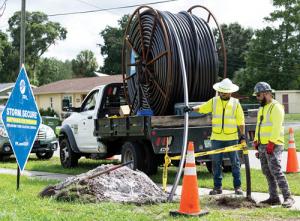
PUF's Steve Mitnick: What are some of the interesting innovations FPL is applying to its undergrounding pilot?
Jerry Cook: We will have completed more than five hundred neighborhood undergrounding projects by the end of this year as part of our pilot and we learn with each one. There's no substitute for real-world experience. As we've gained more experience, we have identified more efficient design and construction practices and learned better ways to handle permitting and contracting, traffic-control measures, and other processes that will help us with future undergrounding.
We use the latest horizontal drilling technology – directional boring and missile boring equipment – to minimize disruptions to customers' properties. Our crews also use handheld ground-penetrating radar devices to detect underground obstacles. We also try to reduce inconveniences to our customers by putting lines, where it's feasible, in public rights of way rather than private property.
We've also begun putting more smart grid technology underground to enhance reliability. FPL is already a leader in using automated lateral switches, automated feeder switches, and other intelligent devices on overhead lines.
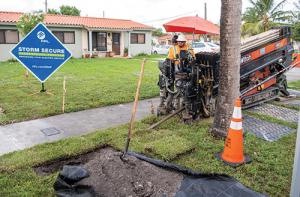 FPL uses directional boring to minimize disruptions when installing underground power lines in its Storm Secure Underground Pilot Program. When complete, FPL restores property to its previous condition. This is in Hialeah.
FPL uses directional boring to minimize disruptions when installing underground power lines in its Storm Secure Underground Pilot Program. When complete, FPL restores property to its previous condition. This is in Hialeah.
Now we're installing automated lateral switch technology on underground projects. These devices help us detect potential issues before they become problems and speed restoration if there is an outage.
We've also learned a lot about our customers and the best ways to communicate with them. During the early stages of the pilot in 2018 and 2019, we conducted a lot of face-to-face meetings with community groups and individual customers to explain the program and answer their questions.
But COVID-19 pushed us toward more videoconferencing and electronic communication – even things like e-signatures and e-notaries for easements and junction box agreements, which turn out to be more efficient than paperwork.
PUF: How have these innovations affected cost and reliability?
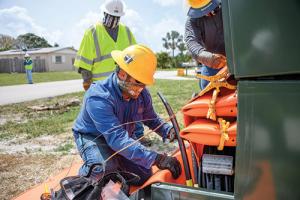 A crew works on a transformer in a neighborhood in Tequesta, Fla., as part of FPL’s Storm Secure Underground Pilot Program.
A crew works on a transformer in a neighborhood in Tequesta, Fla., as part of FPL’s Storm Secure Underground Pilot Program.
Jerry Cook: It's hard to single out any one big innovation. There are probably two dozen things we've learned, developed, and refined during this pilot that have improved efficiency and reduced costs.
As far as reliability, we have seen that underground lines are far more reliable than overhead lines, both in severe weather and under blue-sky conditions. During Hurricane Irma, underground neighborhood power lines performed eighty-five percent better than overhead lines. During day-to-day operations, underground lines are more than fifty percent more reliable.
PUF: What has been the response to the pilot by customers and other stakeholders?
Jerry Cook: Customers have been overwhelmingly positive. Before we begin any digging, we do extensive customer outreach so people understand what we're doing and how it will benefit them. We give them an opportunity to ask questions and raise any concerns.
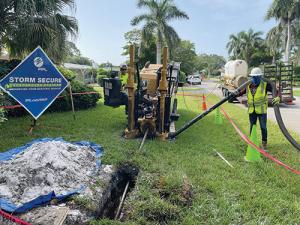 FPL installing underground power lines in Naples, Fla., as part of its Storm Secure Underground Pilot Program.
FPL installing underground power lines in Naples, Fla., as part of its Storm Secure Underground Pilot Program.
We work with people on the location of pad-mounted transformer boxes and other concerns they may have. Some people are hesitant to have a transformer in their yard.
To help address that, we have an augmented reality tool we can use so customers can visualize how the transformer will look on their property. The boxes are usually twenty-six inches tall and not as obtrusive as people fear.
Once we begin construction, in addition to minimizing disruptions to each customer's property, we emphasize to our crews the importance of being courteous and professional. When the construction is done, we restore the property to its original condition or better.
We've had customers tell us it's like we were never there. After the underground service is connected, customers appreciate the improved reliability.
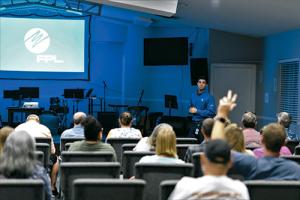 Extensive customer outreach, in-person or virtual, is a key component of FPL’s Storm Secure Underground Pilot Program. This meeting was in 2019 in Palm Beach Gardens.
Extensive customer outreach, in-person or virtual, is a key component of FPL’s Storm Secure Underground Pilot Program. This meeting was in 2019 in Palm Beach Gardens.
For example, there's a customer in Martin County whose lines were put underground more than two years ago, and he has sent a couple of emails since then just to thank us because his lights stayed on when a storm went through that might have caused outages in the past.
PUF: How is a particular project selected, designed, and undertaken?
Jerry Cook: One of the most common questions we get is from people who see other communities benefiting from undergrounding and ask, how can my neighborhood become a part of the program? We get asked that by homeowners and elected officials.
We select neighborhoods for the pilot based on data – outages during Hurricanes Mathew or Irma; a history of vegetation-related service interruptions; and other reliability metrics. Our work plan is approved each year by the Florida Public Service Commission. So, a community can't lobby FPL to get moved up the list, even though many would like to.
We've been selecting projects based on reliability data for each neighborhood power line or lateral. We chose that approach so we could get experience working on a wide variety of projects throughout our service area, even though we knew that working on one lateral over here and another one over there isn't always the most efficient way to mobilize and demobilize crews and equipment.
Now we are beginning to evaluate the data based on main power lines or feeders, each of which supplies power to multiple laterals. With the feeder-based approach, we expect to improve efficiency because crews will be able to focus work on a more concentrated area at a time.
PUF: What are the benefits in terms of resilience?
Jerry Cook: After the historic hurricane seasons of 2004-05, FPL set out to build a stronger, smarter, more storm-resilient energy grid for our customers. Undergrounding neighborhood power lines is one piece of that, along with strengthening transmission structures and main power lines to withstand stronger winds; increasing our pole inspections and tree trimming; adding flood-protection measures at substations; and installing more than a hundred and seventy thousand intelligent devices along the grid.
We've seen impressive results. Because of the hardening program we began after Hurricane Wilma in 2005, we were able to get people's lights on much faster when Hurricane Irma hit in 2017, even though Irma was a bigger, more powerful storm. The average customer outage for Wilma was 5.4 days but for Irma it was only 2.1 days.
These hardening measures also provide benefits in good weather. Our day-to-day reliability has improved nearly forty percent since 2006 and last year FPL ranked best in reliability among major utilities in Florida. We also won the national ReliabilityOne award from PA Consulting for the fifth time in six years.
Because we have a culture of continuous improvement at FPL, we're never satisfied and are always looking for ways to improve service to our customers while keeping bills below the national average.
That's how the neighborhood undergrounding pilot started. Even though we had that big improvement in restoration time from Wilma to Irma, we saw that we could do more.
The leading cause of outages during Irma was vegetation blowing into overhead power lines. Putting more power lines underground provides a direct reliability improvement for the people who get undergrounded. It also benefits all our customers because it reduces restoration time for everyone.
We've learned a lot from this undergrounding pilot over the last three-plus years. As we continue to bring the benefits of undergrounding to more of our service area in the years ahead, we will keep leveraging technology and improving and becoming more efficient to benefit our customers.
Lead image: A crew feeds conduit as part of a Storm Secure Underground Pilot Program project in Sarasota.
Lines Underground Innovations
Articles
- They're Innovating Undergrounding, by PUF's Steve Mitnick
- PG&E's Landmark RFI to Underground Ten Thousand Miles of Lines
Conversations



